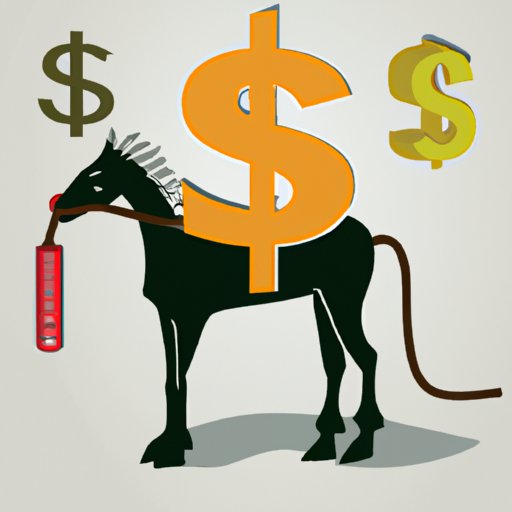Introduction
If you’ve ever considered owning a horse, you’ve likely asked yourself the question: How much does it cost? The cost of owning a horse varies greatly depending on the type of horse, its age, and its needs. On average, you can expect to spend anywhere from several hundred dollars up to several thousand dollars each month. In this article, we’ll break down the true cost of horse ownership so you can make an informed decision about whether or not the expense is worth it.

Breaking Down the Cost of Owning a Horse
When it comes to buying a horse, the initial purchase price will vary widely depending on the breed, age, and condition of the horse. Generally speaking, horses can range in price from a few hundred dollars to tens of thousands of dollars. According to the American Association of Equine Practitioners, the average cost of a horse is around $4,000.
Once you own a horse, the average monthly costs of keeping it can range from $100 to $500. These costs typically include basic necessities such as food, shelter, and veterinary care. Depending on the individual needs of your horse, there may also be additional expenses for things like farrier services, supplements, and grooming supplies. It’s important to factor these costs into your budget when deciding if you can afford to own a horse.
How to Budget for Horse Ownership
Before investing in a horse, it’s important to understand all of the financial obligations that come with ownership. A good way to do this is to set up a budget. Start by listing out all of the expected costs of owning a horse, such as feed, hay, veterinary care, and farrier care. Then, calculate how much you can realistically afford to spend each month. Once you have a budget in place, you can start looking for a horse that fits within your means.
There are also ways to save money when it comes to horse ownership. One option is to find a local boarding facility where you can keep your horse at a discounted rate. You can also look for deals on supplies and equipment, and consider DIY projects when possible. Finally, consider joining a riding club or taking lessons from a trainer — these activities can help you save money in the long run by improving your skills as a rider.
What are the Hidden Costs of Owning a Horse?
In addition to the expected costs of owning a horse, there are also some unexpected expenses to consider. For example, if your horse gets injured or ill, there could be significant veterinary bills. There may also be other one-time expenses such as shoeing, dental care, and vaccinations. Additionally, some horses require specialized care, such as regular chiropractic visits or massage therapy.
It’s also important to think about the long-term costs of horse ownership. Over time, you may need to invest in new equipment, such as saddles, bridles, and halters. And if you plan to compete in shows or events, there will be additional fees associated with registration, travel, and lodging.

The True Cost of Horse Ownership: A Comprehensive Guide
At the end of the day, the true cost of horse ownership depends on a variety of factors. To get a better idea of what you can expect to pay, take the time to research the type of horse you’re interested in and the related expenses. There are many helpful resources available online, including budgeting worksheets, cost calculators, and tips for saving money.
It’s also important to remember that owning a horse is a major commitment. Not only financially, but also in terms of time and energy. Before investing in a horse, make sure you know exactly what’s involved and that you’re prepared to take on the responsibility.
Conclusion
The cost of owning a horse can range from a few hundred dollars to several thousand dollars each month. When budgeting for horse ownership, it’s important to factor in the initial purchase price, average monthly costs, and any additional expenses that may arise. Additionally, there are often hidden costs that can add up quickly, such as unexpected veterinary bills and long-term costs of equipment and show fees. By researching the type of horse you’re interested in and understanding the full cost of ownership, you can make an informed decision about whether or not to invest in a horse.
(Note: Is this article not meeting your expectations? Do you have knowledge or insights to share? Unlock new opportunities and expand your reach by joining our authors team. Click Registration to join us and share your expertise with our readers.)
